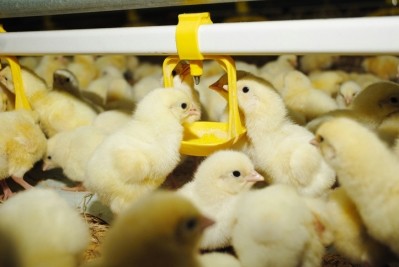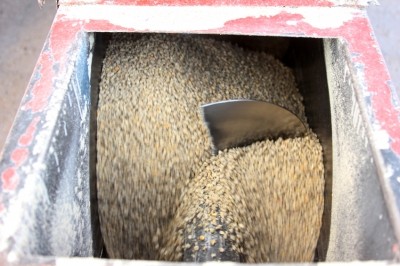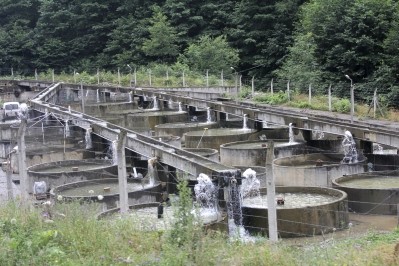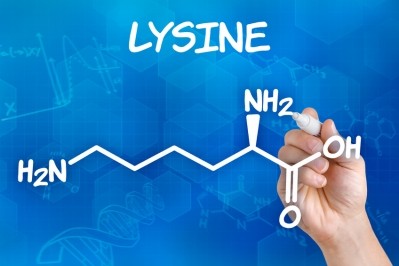Study questions method of formulating pig diets based on recommended AID Lys:ME ratio
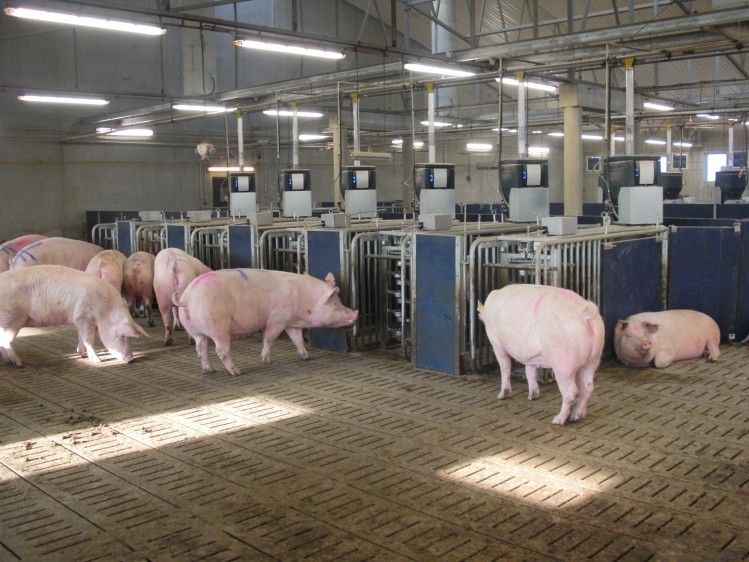
Researchers working on a team led by Michael Azain, professor in the animal and dairy science department of the University of Georgia, undertook trials to determine the performance response to changes in dietary fat, protein, and fiber content in finishing barrows while maintaining a constant apparent ileal digestible (AID) Lysine (Lys) to metabolizable energy (ME) ratio (AID Lys:ME).
Their results demonstrated, they said, that only feeding a diet at recommended digestible Lys:ME is not specific enough to maximize growth performance. "The finishing swine in this study had the most efficient gain at a diet containing 0.52% digestible Lys with 3.60 Mcal ME/kg of diet," said the team.
A quadratic effect of increasing dietary Lys was seen on ADG on day 28 of the trial, they continued, showng the addition of Lys increased gain.
They called for further research to test the optimal nutrient density using NRC, 1998 and NRC, 2012 recommendations of weaning and growing swine.
Background to research
“We started this partly as a demonstration of basic principles of nutrition related to energy density and amino acid requirements,” researcher Paul Cline, now nutrition and research manager at Christensen Family Farms, told us. “Energy density is known to regulate feed intake and we wanted to explore the effect of maintaining a constant energy to amino acid ratio on performance of the pigs.”
The ability to feed alternative feedstuffs without negative effects on carcass composition and feed efficiency is essential for swine producers to maintain profitability, said the researchers. They said it is generally accepted that growing–finishing pigs will eat to meet their energy requirement, at least within a practical range of the nutrient density of the diet (Ellis and Augspurger, 2001).
It is similarly assumed, noted the authors, that dietary amino acids must be adjusted in the diet to change proportionally to dietary energy (Lewis, 2001). However, with the use of alternative feedstuffs that contain higher levels of fiber or fat or both, meeting the amino acid and energy requirements can be a challenge.
Previous studies have demonstrated that as the Lys:ME increases, pigs become more efficient and increase average daily gain (Chiba et al., 1991; De La Llata et al., 2007b; Main et al., 2008). The authors said there have been numerous studies investigating the effect of Lys:ME on performance of growing–finishing swine. However, these studies adjust the Lys:ME as nutrients are added to the diet and all these studies were maintained above the NRC (1998) recommendations (Apple et al., 2004; De La Llata et al., 2007b; Main et al., 2008).
The scientists added: “There are no current studies on the effect of changing nutrient density of the diet while maintaining a constant Lys:ME. The importance of having an understanding of the ratio would be analogous to understanding the ideal pattern of amino acids. Once the ideal pattern (NRC, 1998 and NRC, 2012) is known relative to Lys, determining the Lys requirement will then set all other essential amino acids in the diet.
Similarly, since energy density of the diet determines intake, the Lys to energy ratio in the diet will determine Lys intake at a particular energy level."
Therefore, said the researchers, the objective of their study was to determine if growth performance and digestibility of the feed consumed by barrows are effected by adjusting the energy and digestible Lys concentration of the diet, below and above NRC (1998) recommendations, while maintaining a constant AID Lys:ME.
Study methodology
In the experiment, two groups of 25 pigs were assigned to one of five trial diets containing 0.4, 0.44, 0.48, 0.52 and 0.56% digestible lysine with a constant AID lysine to ME ratio, said researchers.
Altering the lysine was done by changing the proportions of corn and soybean meal, while energy was altered through amount of cellulose and fat included, they said. Dietary energy was reduced by adding fiber.
Pigs were fed for 28 days and body weights, feed intake along with backfat and loin eye area (LEA) measurements were recorded on days 14 and 28, they said. Blood samples were taken on day 28 to check serum urea nitrogen, insulin, T3 and T4 levels.
Results
“When pigs are fed at a constant AID Lys:ME of 1.44 g Lys/Mcal ME, changes in nutrient density of the diets can result in changes in performance,” said researchers.
“Maintaining a constant Lys:ME across all dietary energy concentrations may not result in optimal performance response as observed by pigs fed dietary energy below 3.00 Mcal/kg and above 3.55 Mcal/kg,” they added.
A linear effect was seen as amounts of lysine were increased in the diet, said researchers. And there was a quadratic effect on body weights at day 28.
“The pigs fed 0.52% AID Lys diet gained the most weight,” they said. “The final body weight for pigs on 0.40% digestible Lys diet was 7% less than pigs on 0.52% Lys diet. Body weight of pigs fed the 0.56% digestible Lys was not different than those fed 0.52%.”
There also was a linear effect for average daily gain (ADG) for days 0-14, they said. A quadratic effect was found for days 14-28 and 0-28, and pigs getting the 0.52% diet had the best ADG.
Pigs getting the 0.48% lysine diet had the largest feed intake, said researchers. And feed efficiency increased linearly.
“Feed intake decreased linearly for d 14–28 in pigs fed diets with digestible Lys increasing from 0.40% to 0.56% lysine,” they said. “During the entire study, there was a significant linear and quadratic effect of diet on feed intake with intake decreasing as digestible Lys increased.”
Energy digestibility increased with the larger amounts of lysine in the diet as did nitrogen, fat, NDF and hemicellulose digestibility, they said. There also was a trend for backfat and loin eye area fat to be thicker as the amount of lysine increased.
“The one surprising result is on the highest energy diet that the pigs really did eat to the same calorie level,” said Cline. “We would have expected those pigs to maintain the improved linear performance, but maybe with that much added fat there was some other biological reason those pigs didn’t perform better than the 0.52% group of pigs.”
Looking forward, there needs to be more work done examining amino acid ratios in finishing diets as there are some ratios in the 2012 National Research Council (NRC), like isoleucine: lysine that may not be entirely accepted, he said.
“The question on this amino acid in particular is: Is there an interaction between BCAA [branched-chain amino acid] and a specific BCAA requirement,” continued Cline. “If leucine and valine are high in the diet, then do isoleucine requirements change?”
Effects of dietary digestible Lys at a constant Lys to Metabolizable Energy (ME) ratio on the performance of pigs (M Azain et al)
Digestible Lys (%): | 0.40 | 0.44 | 0.48 | 0.52 | 0.56 | SEMb | P-valuec | |
ME (Mcal/kg): | 2.78 | 3.05 | 3.33 | 3.60 | 3.86 | Linear | Quadratic | |
Body Weight (kg) | ||||||||
d 0 | 85.3 | 85.3 | 85.0 | 84.6 | 85.3 | 0.46 | 0.63 | 0.39 |
d 14 | 97.4 | 99.5 | 100.8 | 102.3 | 101.8 | 0.84 | 0.01 | 0.12 |
d 28 | 112.2 | 117.0 | 118.1 | 120.7 | 116.6 | 1.46 | 0.01 | 0.01 |
ADG (kg/day) | ||||||||
d 0–14 | 0.86 | 1.01 | 1.13 | 1.27 | 1.18 | 0.06 | 0.01 | 0.04 |
d 14–28 | 1.06 | 1.25 | 1.23 | 1.31 | 1.06 | 0.08 | 0.81 | 0.01 |
d 0–28 | 0.96 | 1.13 | 1.18 | 1.29 | 1.12 | 0.05 | 0.01 | 0.01 |
ADFI (kg/day) | ||||||||
d 0–14 | 3.30 | 3.56 | 3.61 | 3.50 | 3.12 | 0.11 | 0.24 | 0.01 |
d 14–28 | 3.88 | 3.97 | 3.69 | 3.68 | 3.17 | 0.14 | 0.01 | 0.09 |
d 0–28 | 3.59 | 3.77 | 3.65 | 3.59 | 3.15 | 0.11 | 0.01 | 0.01 |
Feed efficiency (Gain:Feed) | ||||||||
d 0–14 | 0.26 | 0.29 | 0.31 | 0.36 | 0.37 | 0.01 | 0.01 | 0.91 |
d 14–28 | 0.27 | 0.32 | 0.34 | 0.36 | 0.33 | 0.02 | 0.01 | 0.03 |
d 0–28 | 0.27 | 0.30 | 0.32 | 0.36 | 0.35 | 0.01 | 0.01 | 0.10 |
Caloric intake (Mcal/day) | ||||||||
d 0–14 | 8.98 | 10.69 | 11.81 | 12.42 | 11.93 | 0.35 | 0.01 | 0.01 |
d 14–28 | 10.57 | 11.92 | 12.07 | 13.07 | 12.12 | 0.46 | 0.01 | 0.04 |
d 0–28 | 9.77 | 11.31 | 11.94 | 12.74 | 12.02 | 0.34 | 0.01 | 0.01 |
Lys intake (g/day)d | ||||||||
d 0–14 | 16.5 | 19.6 | 21.6 | 22.8 | 21.9 | 0.65 | 0.01 | 0.01 |
d 14–28 | 19.4 | 21.9 | 22.1 | 24.0 | 22.2 | 0.85 | 0.01 | 0.04 |
d 0–28 | 17.9 | 20.7 | 21.9 | 23.4 | 22.0 | 0.63 | 0.01 | 0.01 |
Source: Journal of Livestock Science
Title: Interaction of dietary energy and protein on growth performance, carcass characteristics and digestibility in finishing barrows when fed at a constant digestible lysine to metabolizable energy ratio
DOI: doi:10.1016/j.livsci.2015.11.027
Authors: P.M. Cline, T.C. Tsai, A.M. Stelzleni, C.R. Dove, and M. Azain
